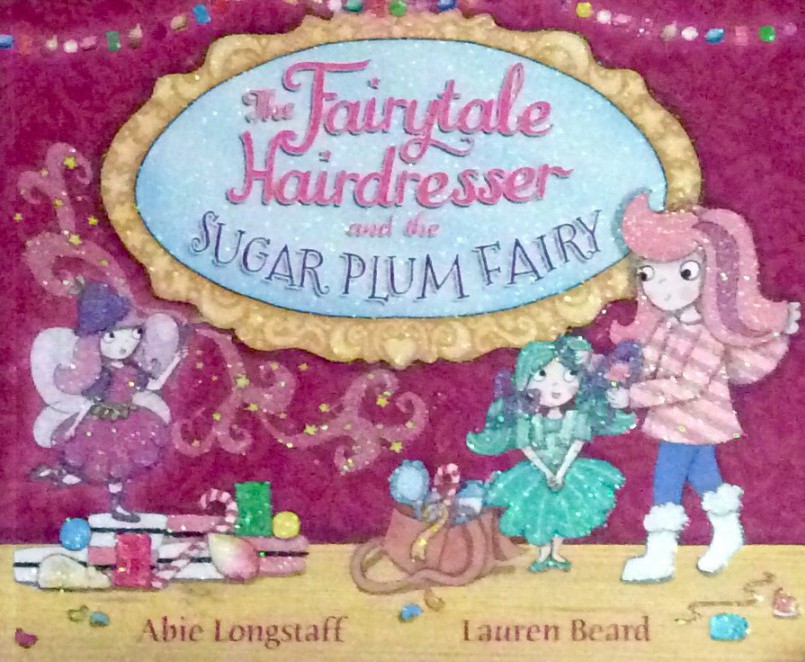Inspiring Young Readers
 posted on 11 Dec 2016
posted on 11 Dec 2016
The Fairytale Hairdresser and the Sugar Plum Fairy by Abie Longstaff, illustrated by Lauren Beard
This is the latest in a very successful series but looking very pink, glittery and ' girly' it isn't normally the kind of picture book that I would be drawn to. But this is actually a charming little fantasy world with an interesting back story. The author, Abie Longstaff explains that, as the eldest of six sisters she became an expert at creative imaginative play. They played for many happy hours creating schools, libraries and various shops. One of the favourite games was to play at being hairdressers and it was the minutia of booking appointments in notebooks and organising the shampoo bottles and the like that fascinated them all. This chimed with me as I can remember similar intricate games that built a cosy toy town version of the real world in which I was in complete control. This is what the author has tapped into very successfully and added in the ingredients of recognisable storybook people and creatures to populate the place. This immediately provides plenty of scope for developing character because the child reader often already has an established reading relationship with them. It is by no means a new idea and has most famously been used by Janet and Allan Ahlberg in their Jolly Postman series, but it works very well.
Every book is centred around Kittie Lacey, 'the best Hairdresser in the land' whose shop is one of an old fashioned high street that includes Dr B.B. Wolf Opticians with the slogan ' All The Better To See You With' and suchlike, it must be tremendous fun to create these. The cover of the book is a recognisable brand for fans with its banner headline at the centre and pink haired Kitty doing her stuff. Each story focuses on a particular fairytale character, which means that this series could go on for a very long time. The Sugar Plum Fairy from The Nutcracker Suite ballet by Tchaikovsky is an unusual choice as not all readers will be familiar with the story, but on the other hand it immediately gives it a Christmassy flavour. The scene is set when we learn the village is about to put on a production of the show and so everyone needs to look their best. For instance we learn that Rapunzel presents a hairdressing challenge as she needs her long tresses is be managed into an impressive bun and I like the detail in the colourful and detailed illustrations that shows The Little Mermaid reading a magazine with her fishy tail immersed in a basin of water as she waits for her turn. This is clearly the kind of salon that goes out of its way to accommodate the needs of all its customers.
As with many ballets, the narrative is a bit thin and, having watched a performance only yesterday evening, I realise that its enduring magical appeal lies in the stunning scenery, costumes and the beautiful set piece dancing. Longstaff acknowledges this challenge and explains that she and the illustrator had to work especially hard to make the links with the story. They do this by creating a problem that needs to be solved: Kitty's friend Clara has found a wooden nutcracker carved in the shape of a soldier which she brings to put on the Christmas tree next to the ballet theatre. As they decorate the tree Kitty notices that Sugarplum, one of the fairies in the village is putting up posters for the missing Prince Armand. Her fear is that he has been captured by the evil Mouse King and Queen. Magic is at the heart of the original story and this Sugar Plum Fairy is able to reduce everyone down in size so that they can enter the splendid Land of Sweets hidden between the branches of the Christmas tree. Once the prince is discovered, more magic means that all the toys on the tree come to life to help with his release. There is a quaintness about the range of toys depicted that conforms to the conventions of the original ballet, but alongside the rocking horse and the teddy bear we see a robot and a slinky pig.
There is plenty of battle action at the centre of the book with the eventual capture of the baddies and transformation of the nutcracker into the Prince. An interesting observation is that the Mouse King and Queen are then sent to prison and on her website Longstaff has pointed out that there is a very efficient and fair criminal justice system in Fairyland Village. As a trained barrister and now working for a charity that deals with policing and human rights, she likes to reassure her readers that bad deeds will be punished but that once criminals have served their sentence they are released back into the community for a second chance.
Clara and the Prince live happily ever after in the Land of Sweets and The Sugar Plum Fairy tries on a variety of outfits and hairstyles so that she can play a starring role in the show with Kitty and her friends back in the village.
Reading this book has made me curious to look at the other ones in the series, particularly as the author has stated that she aims to present a wide range of assertive female characters and so rather cleverly subverts my initial perceptions about girly stereotypes. But it seems a shame that the overall pinkiness of the design plus the subject matter probably means that most little boys would be unimpressed and so would miss out on enjoying this imaginative little world.
Karen Argent
December 2016